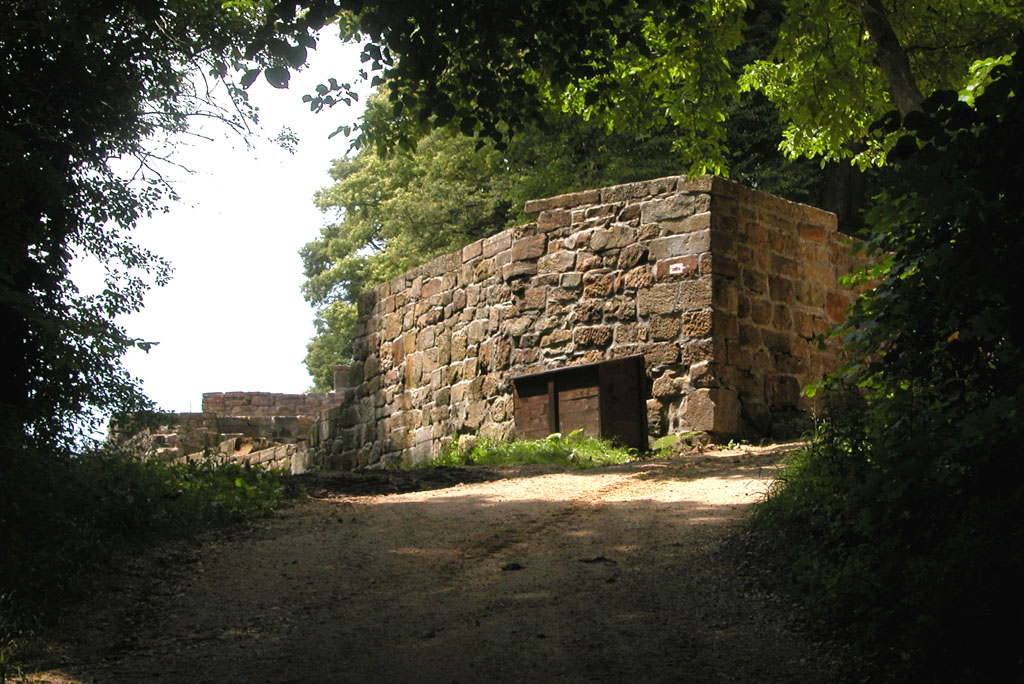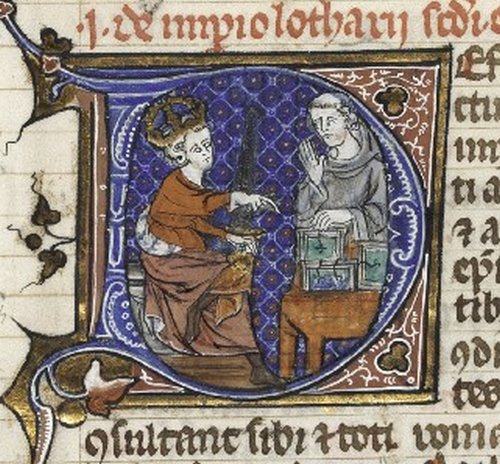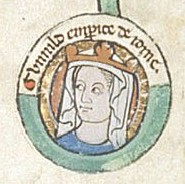|
Salian Dynasty
The Salian dynasty or Salic dynasty () was a dynasty in the High Middle Ages. The dynasty provided four kings of Germany (1024–1125), all of whom went on to be crowned Holy Roman emperors (1027–1125). After the death of the last Ottonian emperor in 1024, the Kingdom of Germany and later the entire Holy Roman Empire passed to Conrad II, a Salian. He was followed by three more Salian rulers: Henry III, Henry IV, and Henry V. They established their monarchy as a major European power. The Salian dynasty developed a permanent administrative system based on a class of public officials answerable to the crown. Origins and name Modern historians suppose that the Salians descended from the Widonids, a prominent noble kindred emerging in the 7th century. Their estates were located at the confluence of rivers Moselle and Saar and they supported the Carolingians. The Widonids' eastward expansion towards the river Rhine started after they founded Hornbach Abbey in th ... [...More Info...] [...Related Items...] OR: [Wikipedia] [Google] [Baidu] |
Speyer Cathedral
Speyer Cathedral, officially ''the Imperial Cathedral Basilica of the Assumption and St Stephen'', in Latin: Domus sanctae Mariae Spirae (German: ''Dom zu Unserer lieben Frau in Speyer'') in Speyer, Germany, is the seat of the Roman Catholic Bishop of Speyer and is suffragan to the Roman Catholic Archdiocese of Bamberg. The cathedral, which is dedicated to St. Mary, patron saint of Speyer ("Patrona Spirensis") and St. Stephen is generally known as the Kaiserdom zu Speyer (Imperial Cathedral of Speyer). Pope Pius XI raised Speyer Cathedral to the rank of a minor basilica of the Roman Catholic Church in 1925. Begun in 1030 under Conrad II, Holy Roman Emperor, Conrad II, with the east end and high vault of 1090–1103, the imposing triple-aisled vaulted basilica of red sandstone is the "culmination of a design which was extremely influential in the subsequent development of Romanesque architecture during the 11th and 12th centuries". As the burial site for Salian dynasty, Salian, Hou ... [...More Info...] [...Related Items...] OR: [Wikipedia] [Google] [Baidu] |
Hohenstaufen
The Hohenstaufen dynasty (, , ), also known as the Staufer, was a noble family of unclear origin that rose to rule the Duchy of Swabia from 1079, and to royal rule in the Holy Roman Empire during the Middle Ages from 1138 until 1254. The dynasty's most prominent rulers – Frederick I (1155), Henry VI (1191) and Frederick II (1220) – ascended the imperial throne and also reigned over Italy and Burgundy. The non-contemporary name of 'Hohenstaufen' is derived from the family's Hohenstaufen Castle on Hohenstaufen mountain at the northern fringes of the Swabian Jura, near the town of Göppingen. Under Hohenstaufen rule, the Holy Roman Empire reached its greatest territorial extent from 1155 to 1268. Name The name Hohenstaufen was first used in the 14th century to distinguish the 'high' (''hohen'') conical hill named Staufen in the Swabian Jura (in the district of Göppingen) from the village of the same name in the valley below. The new name was applied to the hill c ... [...More Info...] [...Related Items...] OR: [Wikipedia] [Google] [Baidu] |
Library Of Congress
The Library of Congress (LOC) is a research library in Washington, D.C., serving as the library and research service for the United States Congress and the ''de facto'' national library of the United States. It also administers Copyright law of the United States, copyright law through the United States Copyright Office, and it houses the Congressional Research Service. Founded in 1800, the Library of Congress is the oldest Cultural policy of the United States, federal cultural institution in the United States. It is housed in three buildings on Capitol Hill, adjacent to the United States Capitol, along with the National Audio-Visual Conservation Center in Culpeper, Virginia, and additional storage facilities at Fort Meade, Fort George G. Meade and Cabin Branch in Hyattsville, Maryland. The library's functions are overseen by the librarian of Congress, and its buildings are maintained by the architect of the Capitol. The LOC is one of the List of largest libraries, largest libra ... [...More Info...] [...Related Items...] OR: [Wikipedia] [Google] [Baidu] |
Federal Research Division
The Federal Research Division (FRD) is the research and analysis unit of the United States Library of Congress. The Federal Research Division provides directed research and analysis on domestic and international subjects to agencies of the United States government, the District of Columbia, and authorized federal contractors. As expert users of the vast English and foreign-language collections of the Library of Congress, the Division's area and subject specialists employ the resources of the world's largest library and other information sources worldwide to produce impartial and comprehensive studies on a cost-recovery basis. The Federal Research Program is run by the Federal Research Division (FRD), the fee-for-service research and analysis unit within the Library of Congress. The Federal Research Program of the Library of Congress was authorized by the United States Congress in accordance with the Library of Congress Fiscal Operations Improvement Act of 2000 (2 U.S.C. 182c). FR ... [...More Info...] [...Related Items...] OR: [Wikipedia] [Google] [Baidu] |
Henry V, Holy Roman Emperor
Henry V (; probably 11 August 1081 or 1086 – 23 May 1125) was King of Germany (from 1099 to 1125) and Holy Roman Emperor (from 1111 to 1125), as the fourth and last ruler of the Salian dynasty. He was made co-ruler by his father, Henry IV, in 1098. In Emperor Henry IV's conflicts with the imperial princes and the struggle against the reform papacy during the Investiture Controversy, young Henry V allied himself with the opponents of his father. He forced Henry IV to abdicate on 31 December 1105 and ruled for five years in compliance with the imperial princes. He tried, unsuccessfully, to withdraw the regalia from the bishops. Then in order to at least preserve the previous right to invest, he captured Pope Paschal II and forced him to perform his imperial coronation in 1111. Once crowned emperor, Henry departed from joint rule with the princes and resorted to earlier Salian autocratic rule. After he had failed to increase control over the church, the princes in Saxony and o ... [...More Info...] [...Related Items...] OR: [Wikipedia] [Google] [Baidu] |
Henry IV, Holy Roman Emperor
Henry IV (; 11 November 1050 – 7 August 1106) was Holy Roman Emperor from 1084 to 1105, King of Germany from 1054 to 1105, King of Italy and List of kings of Burgundy, Burgundy from 1056 to 1105, and Duke of Bavaria from 1052 to 1054. He was the son of Henry III, Holy Roman Emperor—the second monarch of the Salian dynasty—and Agnes of Poitou. After his father's death on 5 October 1056, Henry was placed under his mother's guardianship. She made grants to German aristocrats to secure their support. Unlike her late husband, she could not control the election of the popes, thus the idea of the Libertas ecclesiae, "liberty of the Church" strengthened during her rule. Taking advantage of her weakness, Archbishop Anno II of Cologne kidnapped Henry in April 1062. He administered Germany until Henry came of age in 1065. Henry endeavoured to recover the royal estates that had been lost during his minority. He employed low-ranking officials to carry out his new policies, causing disco ... [...More Info...] [...Related Items...] OR: [Wikipedia] [Google] [Baidu] |
Henry III, Holy Roman Emperor
Henry III (, 28 October 1016 – 5 October 1056), called the Black () or the Pious, was Holy Roman Emperor from 1046 until his death in 1056. A member of the Salian dynasty, he was the eldest son of Conrad II and Gisela of Swabia. Henry was raised by his father, who made him Duke of Duchy of Bavaria, Bavaria in 1026, appointed him co-ruler in 1028 and bestowed him with the duchy of Swabia and the Kingdom of Burgundy ten years later in 1038. The emperor's death the following year ended a remarkably smooth and harmonious transition process towards Henry's sovereign rule, that was rather uncharacteristic for the Ottonian dynasty, Ottonian and Salian dynasty, Salian monarchs. Henry succeeded Conrad II as Duke of Carinthia and King of Italy and continued to pursue his father's political course on the basis of ''virtus et probitas'' (courage and honesty), which led to an unprecedented sacral exaltation of the kingship. In 1046 Henry ended the History of the papacy (1048–1257), papal s ... [...More Info...] [...Related Items...] OR: [Wikipedia] [Google] [Baidu] |
Conrad II, Holy Roman Emperor
Conrad II (, – 4 June 1039), also known as and , was the Holy Roman Emperor, emperor of the Holy Roman Empire from 1027 until his death in 1039. The first of a succession of four Salian dynasty, Salian emperors, who reigned for one century until 1125, Conrad ruled the kingdoms of Kingdom of Germany, Germany (from 1024), Kingdom of Italy (medieval), Italy (from 1026) and Kingdom of Burgundy, Burgundy (from 1033). The son of Franconian count Henry of Speyer (also Henry of Worms) and Adelaide of Metz of the ''Matfriding dynasty'', that had ruled the Duchy of Lorraine from 959 until 972, Conrad inherited the titles of count of Speyer and Worms, Germany, Worms during childhood after his father had died around the year 990. He extended his influence beyond his inherited lands, as he came into favour of the Princes of the Holy Roman Empire, princes of the kingdom. When the imperial Ottonian dynasty, dynastic line was left without a successor after Emperor Henry II's death in 1024, ... [...More Info...] [...Related Items...] OR: [Wikipedia] [Google] [Baidu] |
Holy Roman Emperors
The Holy Roman Emperor, originally and officially the Emperor of the Romans (; ) during the Middle Ages, and also known as the Roman-German Emperor since the early modern period (; ), was the ruler and head of state of the Holy Roman Empire. The title was held in conjunction with the title of King of Italy (''Rex Italiae'') from the 8th to the 16th century, and, almost without interruption, with the title of King of Germany (''Rex Teutonicorum'', ) throughout the 12th to 18th centuries. The Holy Roman Emperor title provided the highest prestige among medieval Catholic monarchs, because the empire was considered by the Catholic Church to be the only successor of the Roman Empire during the Middle Ages and the early modern period. Thus, in theory and diplomacy, the emperors were considered first among equalsamong other Catholic monarchs across Europe. From an autocracy in Carolingian times (AD 800–924), the title by the 13th century evolved into an elective monarchy, with ... [...More Info...] [...Related Items...] OR: [Wikipedia] [Google] [Baidu] |
Kings Of Germany
This is a list of monarchs who ruled over East Francia, and the Kingdom of Germany (), from the division of the Frankish Empire in 843 and the collapse of the Holy Roman Empire in 1806 until the collapse of the German Empire in 1918: East Francia (843–962) Carolingian dynasty Conradine dynasty Ottonian dynasty Holy Roman Empire (962–1806) The title "King of the Romans", used in the Holy Roman Empire, was, from the coronation of Henry II, considered equivalent to King of Germany. A king was chosen by the German electors and would then proceed to Rome to be crowned emperor by the pope. Ottonian dynasty (continued) Salian dynasty Supplinburger dynasty Hohenstaufen dynasty Interregnum Changing dynasties Habsburg dynasty Modern Germany (1806–1918) Confederation of the Rhine (1806–1813) German Confederation (1815–1866) North German Confederation (1867–1871) German Empire (1871–1918) Note on titles #The Kingdom of Germany started o ... [...More Info...] [...Related Items...] OR: [Wikipedia] [Google] [Baidu] |
High Middle Ages
The High Middle Ages, or High Medieval Period, was the periodization, period of European history between and ; it was preceded by the Early Middle Ages and followed by the Late Middle Ages, which ended according to historiographical convention. Key historical trends of the High Middle Ages include the medieval demography, rapidly increasing population of Europe, which brought about great social and political change from the preceding era, and the Renaissance of the 12th century, including the first developments of rural exodus and urbanization. By 1350, the robust population increase had greatly benefited the European economy, which had reached levels that would not be seen again in some areas until the 19th century. That trend faltered in the early 14th century, as the result of numerous events which together comprised the crisis of the late Middle Ages—most notable among them being the Black Death, in addition to various regional wars and economic stagnation. From , Europ ... [...More Info...] [...Related Items...] OR: [Wikipedia] [Google] [Baidu] |
Dynasty
A dynasty is a sequence of rulers from the same family, usually in the context of a monarchy, monarchical system, but sometimes also appearing in republics. A dynasty may also be referred to as a "house", "family" or "clan", among others. Historians periodization, periodize the histories of many states and civilizations, such as the Roman Empire (27 BC – AD 1453), History of Iran, Imperial Iran (678 BC – AD 1979), Ancient Egypt (3100–30 BC), and History of China#Ancient China, Ancient and Imperial China (2070 BC – AD 1912), using a framework of successive dynasties. As such, the term "dynasty" may be used to delimit the era during which a family reigned. Before the 18th century, most dynasties throughout the world were traditionally reckoned patrilineality, patrilineally, such as those that followed the Franks, Frankish Salic law. In polities where it was permitted, succession through a daughter usually established a new dynasty in her husband's family name. This has ... [...More Info...] [...Related Items...] OR: [Wikipedia] [Google] [Baidu] |












